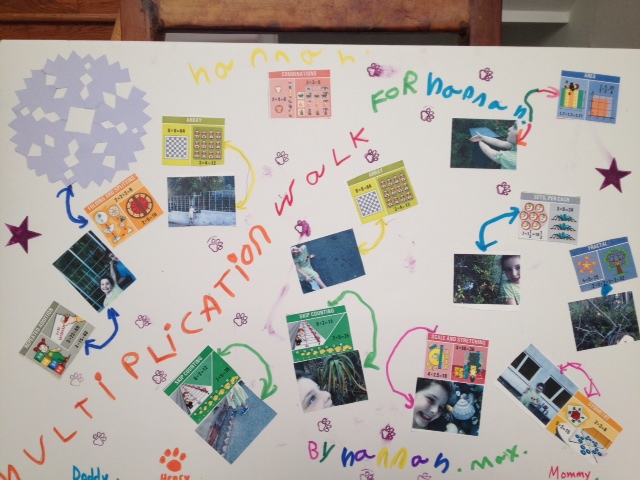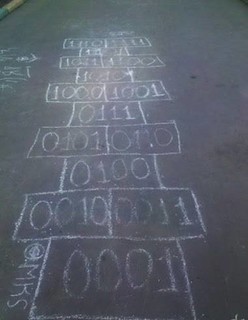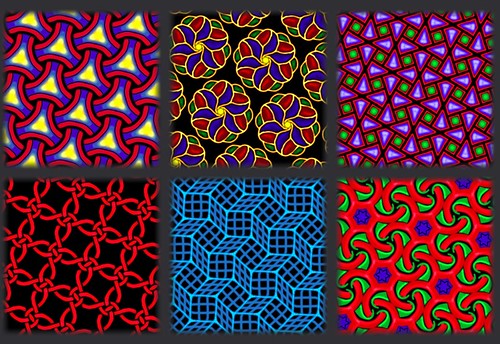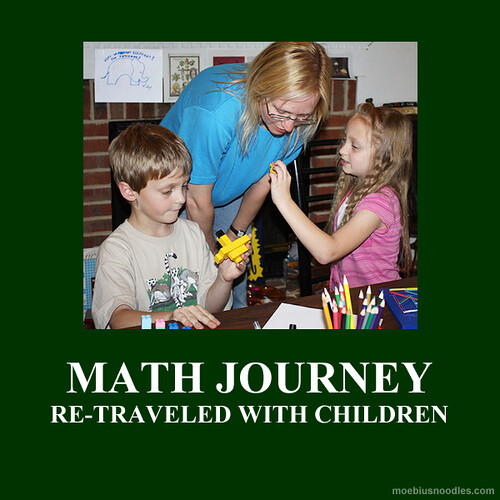WOW! Multiplication Observer: A few conclusions
Thank you everyone who participated in the WOW! Multiplication open course. We will aggregate questions and answers from the Introduction thread, as well as other course resources, into a book on multiplication. As all our materials, it will be an open resource under a Creative Common licence. Thank you for contributing!

Picture: Multiplication Walk poster by Nannan (6) and Keetgi
Here are a few conclusion from the data from course participants. It will help running online courses in the future.
- For a short course, three forum threads are enough: Introduction, Action, and Help/Resources. As much as we want a planning thread (before action) and a reflection thread (after), it messes up the flow and confuses people. The main Action thread has to be “the thing and the whole of the thing” (Terry Pratchett) – planning questions and reports in one space.
- We need a clear place that lists everything there is in the course. New happenings can’t just come by email. Major course tasks – all of them – have to appear right away when the course starts, and can’t be “unlocked” later. Otherwise, people have doubts about the flow.
- For the task design, the Make tasks need to come before Solve/Search tasks. For example, making snowflakes will help people find symmetry models of multiplication during their scavenger hunts. We must explain what this task order does.
- We need an easy, uniform way to share pictures and stories after the main action is done. Participants suggested voice-over tools where kids can explain their photos, for example. We may run a mini-conference for participants, where they do short-short presentations together.
- The mixed age activities remain unclear for many people. We need explicit instructions for adapting activities by age, and for running mixed-age Math Circles.
Happy math adventures, everyone!
Posted in Grow
Binary hopscotch and six-year-olds inspired by calculus: Newsletter September 30, 2013
I am Moby Snoodles, and this is my newsletter. I love to hear from you at moby@moebiusnoodles.com

Blogs and networks

In the #StreetMath collection at our Facebook page, check out binary hopscotch from Dr. Mike’s Math Games. Do try it at home, and share your cute hopscotch ideas with us!

Denise of Let’s Play Math came up with a mirror activity for her Math Circle during our WOW! Multiplication online course. Denise writes:
As usual, the moms enjoyed the activities at least as much as the kids. One expressed surprise at how easily her son understood the basic idea of multiplication, which she had expected would be too hard for a 1st grader. We talked a bit about how much the kids enjoy learning through activities, and yet how prone we all are (especially when we get tired or too busy) to return to the idea that filling out a workbook page is “doing math.”
Are you a blogger? This October, Moebius Noodles will be hosting the 67th Math Teachers at Play blogger carnival. It’s a virtual celebration of your blog posts about math play with kids! By October 10th, submit your blog post via a 2-minute form.
Inspired by Calculus begins October 2 in Apex, NC. Start a local group too!
The first Math Circles for our young calculus program are launching at Apex, NC. Drop us a line if you are interested in making a Circle happen for your kids. Meanwhile, here is information about the two Circles we organized.
Why: Make math your own, to make your own math!
Where: Camp MusArt, 616 West Chatham, Apex.
Who and when: Tuesdays October 1, 8, 15, 22, 29, and November 5, 5:45-6:45 pm for 9-11 year old children. Thursdays October 3, 10, 17, 24, Friday November 1, and Thursday November 7 5:45-6:45 pm for 6-8 year old children. Parents are welcome to help.
Price: $95. Need-based scholarships by application.
Register: 6-8 year olds or 9-11 year olds.
What is bigger than infinity? Can I build an arch or a spiral staircase with Lego blocks? How could Zeno not see that a fast runner will definitely catch up to a slow turtle? Why does the Fibonacci sequence pop up in nature? How can I draw beautiful fractal doodles?
Kids ask the same general questions that inspired the invention of Calculus. With a bit of hands-on exploration, children begin to appreciate finer points of fast and slow motion, series of shrinking and growing things, or curved shapes made of non-curvy blocks.
Join our young calculus adventures this October and November. Our Math Circles are for curious, inquiring, playful families. Children will do a lot of drawing (such as a portrait of infinity), make models out of paper and blocks (such as a Lego parabola roller coaster), and pretend-play (to resolve Zeno’s turtle paradox once and for all). We invite you and your kids to be inspired by calculus!
Sharing
You are welcome to share the contents of this newsletter online or in print. You can also remix and tweak anything as you wish, as long as you share your creations on the same terms. Please credit MoebiusNoodles.com
More formally, we distribute all Moebius Noodles content under the Creative Commons Attribution-NonCommercial-ShareAlike license: CC BY-NC-SA
Talk to you again on October 15th!
Moby Snoodles, aka Dr. Maria Droujkova
Posted in Newsletter
STEMx online conference and resource lists: Newsletter September 15
I am Moby Snoodles, and this is my newsletter. I love to hear from you at moby@moebiusnoodles.com

STEMx Conference
Maria Droujkova and Dmitri Droujkov will be presenting “Advanced Math for the Young, the Very Young, and the Young at Heart” at the Global STEMx Education Conference on September 19th at 8pm Eastern US Time. Join thousands of participants who care about math ed for three days of joyful innovation!

Blogger carnival in October
This October, Moebius Noodles will be hosting the 67th Math Teachers at Play blogger carnival. It’s a virtual celebration of your blog posts about mathematics! By October 10th, submit your blog post via a very short form.

Blogs and networks
Nicholas Johnson aka Math-Explosion on Facebook started to make illustrations for our list “60 ways to stay creative in math.” This is the first one:

If you like lists, here are some more from our blog:
- Adaptations of activities for toddlers and young kids
- Parent roles in a Math Circle: when grown-ups participate
- 12 models of multiplication
- 6 ways to collect pictures
- Becoming invisible and helping students be heroes of their adventures
TocaMates posted a handmade contraption that reminds of the Function Machine activities from the Moebius Noodles book. In response, Michael Kelly wrote:
I like the idea of sending older children to the a photocopier where different amounts of paper go in and are multiplied. (The double sided option adds another variable) Perhaps a shredder that creates 10 strips each time could reverse the idea. But I love the real quality of this splendid machine that caresses the abstract idea of the actual operation into consciousness. There is a line from Maupassant where two lovers sit under a tree as a bird sings beautifully. Neither of them speaks for fear of frightening it away. I think that the appearance of new learning is similar to this lovely metaphor and deserves the same reverence.

From our Facebook collection of #lapware for toddlers and the young at heart, check out the iOrnament app. Scientists call these patterns crystallographic groups, and mathematicians call them wallpaper groups. Finger painting these days is so mathematical!

Sharing
You are welcome to share the contents of this newsletter online or in print. You can also remix and tweak anything as you wish, as long as you share your creations on the same terms. Please credit MoebiusNoodles.com
More formally, we distribute all Moebius Noodles content under the Creative Commons Attribution-NonCommercial-ShareAlike license: CC BY-NC-SA
Talk to you again on September 30th!
Moby Snoodles, aka Dr. Maria Droujkova
Posted in Newsletter





